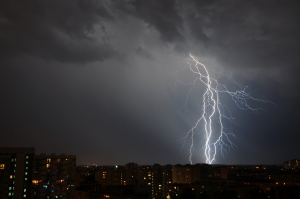Green & Energy
Lightning – A phenomena Of The weather

Lightning is one of the most powerful natural phenomena known to man and it can be deadly. Each day the earth is shaken by 8 million bolts of lightning. More than 90% of bolts fired are within the clouds but a highly charged storm will fire the negative energy from a cloud to the nearest point where there is a positive charge. That nearest point can be a tall building, a blade of grass or even a person – and it happens – around 1000 people die each year after being struck by lightning.
 So how is lightning generated?
So how is lightning generated?
The ingredients needed to create lightning are cold air and warm air – when the two meet the warm air rises and makes thunderstorm clouds. The cold air contains ice crystals and the warm air, water droplets. During a storm the two collide and it is this collision that makes static electrical charges in the clouds. The clouds send the positive charges to the top and negative charges to the bottom. When the bottom negative charge gets strong enough it needs to let out its energy – making lightning. The cloud will send out a ‘step leader’ which will seek a positive ‘streamer’ which will be generated by things on the ground within the area. If and when the two meet this creates a lightning strike.
Bolts of energy can either go to the ground or from cloud to cloud. The bolt will then go back to its cloud and that is when we see a lightning flash which is caused by the heat of the electrical current. A lightning bolt is around 33,000°C, which is hotter than the surface of the Sun, therefore it heats the air around it. As it heats the air this creates the sound we know as thunder.
Lightning Hot Spots
 The Empire State Building in New York receives over 100 strikes per year but the worst area for lightning strikes in the USA is Florida.
The Empire State Building in New York receives over 100 strikes per year but the worst area for lightning strikes in the USA is Florida.
But worldwide research suggests that these are not the top spots and don’t even feature in the top 10 for lightning strikes over the world. Rwanda has been named the lightning capital of the world, although Uganda has one of the highest death rates from lightning strikes. The Ugandan capital, Kampala, has more lightning per year than any other city in Africa. Storms in these areas in 2011 led to around 30 people being killed.
How to keep yourself safe
• The best place to be is inside a building and if this is not possible stay away from open spaces.
• Do not swim.
• Shut off all electrical appliances during a storm and do not use a landline telephone. Power surge protectors do not work for electrical storms – they are designed to protect in surges in normal electricity supplies.
• Do not walk with an umbrella up or any metal object around you.
Lightning is a fascinating to watch but make sure you keep safe.
Featured images:
- License: Royalty Free or iStock source: http://www.sxc.hu/photo/1385041
- License: Royalty Free or iStock source: http://www.sxc.hu/photo/1367265
Colin is writing on behalf of business energy quotes provider and business electricity solutions expert www.havenpower.com
-

 Tech11 years ago
Tech11 years agoCreating An e-Commerce Website
-

 Tech11 years ago
Tech11 years agoDesign Template Guidelines For Mobile Apps
-

 Business6 years ago
Business6 years agoWhat Is AdsSupply? A Comprehensive Review
-

 Business10 years ago
Business10 years agoThe Key Types Of Brochure Printing Services
-

 Tech8 years ago
Tech8 years agoWhen To Send Your Bulk Messages?
-

 Tech5 years ago
Tech5 years ago5 Link Building Strategies You Can Apply For Local SEO
-

 Law5 years ago
Law5 years agoHow Can A Divorce Lawyer Help You Get Through Divorce?
-

 Home Improvement6 years ago
Home Improvement6 years agoHоw tо Kеер Antѕ Out оf Yоur Kitсhеn































